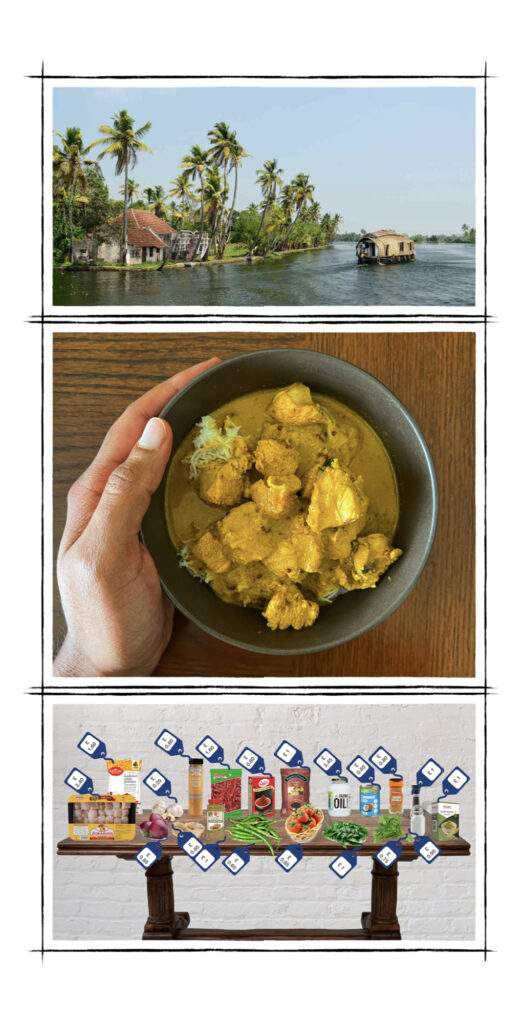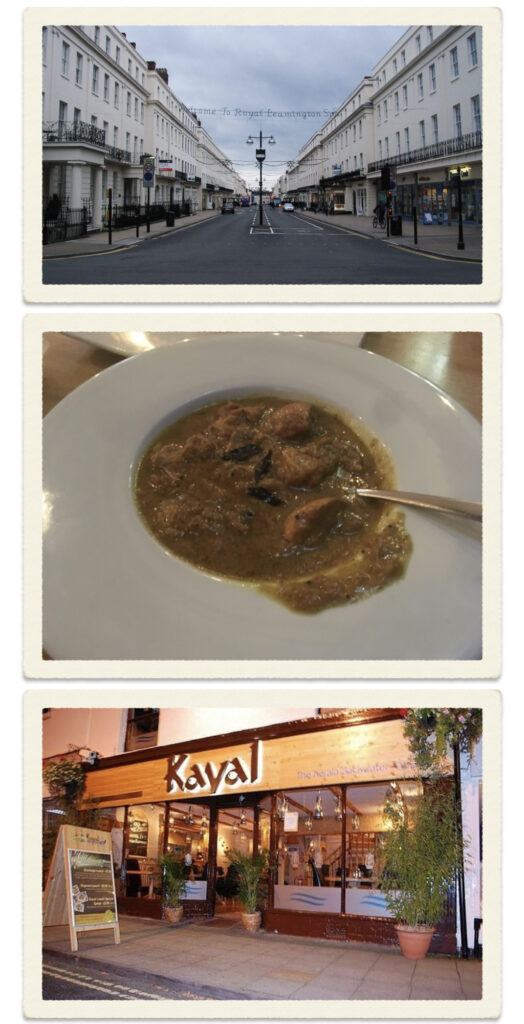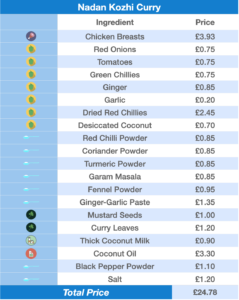
What’s In A Name
Country of Origin – India
State – Kerala
Let’s talk about Curry – the global phenomenon that has taken the entire world by storm!
Okay, wait, let me be a little more specific.
Let’s talk about THE Curry (not Steph or Seth) – the global phenomenon that took the entire culinary world by storm – nearly 200 years ago.
The Curry – or to be more precise, Kari – was coined in the Southern region of India to describe a sauce/relish (for rice dishes) containing curry leaves. It wasn’t until the mid-18th century when the first anglicised translation came into existence
Given the vastness of the sub-continent – India, in particular – it comes as no surprise that the curry has been invented and reinvented countless number of times to the extent that the curry served in the North of India is significantly different to that that is served in the East, West or South of India. For example, a Butter Chicken served on the streets of Punjab is world’s apart from a homemade Chicken Chettinad prepared in the forests of Tamil Nadu.
In this current scenario, the Nadan Kozhi Curry – a dish hailing from one of the Southern-most states in India, and the Land of Spices – Kerala – is the result of an amalgamation of popular local spices and ingredients such as red chillies, curry leaves, black mustard seeds, coconut, and turmeric.

Our Connection
എവിടെ (Where) – Kayal – Royal Leamington Spa, England, UK
എപ്പോൾ (When) – April, 2018
Is there a more feared and dreaded word for an Indian immigrant in the UK than ‘Curry’?! The mere thought of being invited to a “curry house” sends shivers down my spine. Fortunately, my body isn’t aching all the time!
You would think that having colonized the birthplace of the ‘Curry’ (India) for nearly a century, the British would have learnt a thing or two about cooking authentic Indian food. That every household in the kingdom would possess at least one authentic Indian curry recipe, passed down from their ancestors.
Alas, there are but only a few who have managed to master the art of Indian cooking! And a fraction of them are currently employed in the kitchens of Kayal.
Let’s get this out of the way: I was born in the South of India, and yes I have, on occasion, feasted on some authentically delicious Nadan Kozhi Curry.
Why Kayal takes pole position over the others is precisely because of what was written before – of how surprised I was with the quality and authenticity of South Indian food being served, many miles away from home. I was awestruck by the reproduction of each dish – how close it was in looks and taste to what is served back in India.
So much so that it became a regular haunt for dinner when my folks came visiting. Funnily enough, the three times I visited Kayal, I had a separate family member with me!
Nadan Kozhi Curry
Description
"So, you'd like to order one portion of Kerala Chicken Curry? Yes, sir, that's the Nadan Kozhi Curry. Well, sir, if you want me to be pedantic about it, it's the Kozhi Kari. Yes, sir, with an i. So, one portion of the Kozhi Kari? K!"
Ingredients
Instructions
-
Dice the chicken breasts1 into medium-size chunks. Add them to a large bowl
-
Marinate the chicken with a generous pinch of salt and black pepper powder, the ginger-garlic paste, and half of the prescribed red chilli powder and turmeric powder
-
Give the diced chicken a good massage so as to ensure that all of the pieces are well coated in the marination. Leave it to rest for at least one hour2
-
Whilst the chicken is marinating, it's time to turn our attention to making the curry paste. Roughly chop the red onions, tomato, ginger, garlic, and green chillies
-
Add a heaped tablespoon of coconut oil into a large sauté pan, and bring it over a medium-high heat
-
While the coconut oil melts and warms up, roughly slice 4 curry leaves. Once the oil is hot, add the curry leaves to the pan and let it sizzle for a few seconds
-
Add the dried red chillies and the chopped garlic, ginger, and green chillies. Sauté until the raw smell dissipates
-
Add the chopped onions. Continue to sauté until they turn translucent3
-
Season the mixture with coriander powder, fennel powder, the rest of the red chilli powder and turmeric powder, and a generous pinch of salt. Sauté until the spices coat the entire mixture
-
Add the desiccated coconut. Continue to sauté until the coconut start to colour (due to the spices)
-
Add the chopped tomato to the pan. Sauté until they start to turn mushy. Once the mixture is ready, take it off the heat, and keep it aside to cool
-
Once the mixture has cooled down, slowly pour it all into a blender. Add a quarter cup of water to the mixture. Shut the blender with a lid, and give it a good shake before blitzing. Blitz/Pulse4 until you get a smooth yellow-brown curry paste
-
In the same sauté pan, add another heaped tablespoon of coconut oil and bring it over a medium-high heat
-
Once the oil is warm, sprinkle a handful of black mustard seeds into the pan and wait for them to cackle and pop. Add the rest of the curry leaves into the pan and let them sizzle along with the mustard seeds
-
Slowly pour all of the curry paste from the blender into the pan. Stir for a minute until the mustard seeds and curry leaves mix in with the paste
-
Add the marinated chicken into the pan. Leave the chicken to cook on a medium-high heat for about 5 minutes or until they are almost cooked through (80% cooked)
-
Slowly pour the rest of the water into the pan. Stir until the curry paste starts to become slightly loose and liquid
-
Sprinkle the garam masala and pour the thick coconut milk into the curry and stir until the spices and the milk dissolve in the curry - the curry should slightly lighten in colour owing to the coconut milk
-
Continue cooking the chicken in the curry for another 2-3 minutes on medium-high heat or until it is fully cooked through
-
To Serve (per serving): The Nadan Kozhi Curry can be served either with Malabar Parottas/Rice/Appams/String Hoppers (Idiyappams).
If served with Parotta/Appam, pour a generous ladleful of curry into a small bowl, and serve the parotta/appam on a side plate.
If served with Rice/String Hoppers (Idiyappams), place a heaped tablespoon of rice/a couple of string hoppers into the serving bowl, and pour a ladleful of the kozhi curry over the rice/string hoppers
Note
1. Alternatively, you can use juicier chicken thighs - bone-in or boneless.
2. Ideally, you would like to marinate your diced chicken for 24 hours (or overnight) if possible. However, if there is a time constraint, then let it marinate for a minimum of 1 hour.
3. If at any time, the curry paste mixture gets too dry during the sautéing process, you can add a quarter/half tablespoon of coconut oil.
4. It is ideal if your blender has a Pulse option as this would result in a smoother paste than if you use the general grind/blend option. If you do not have the Pulse option, don't worry, you can use the general setting, although you may have to increase the quantity of water to get a smoother paste.
5. The prices of the ingredients (table below) are only rough estimates and are subject to change!
6. As certain ingredients are common household items - salt, pepper, oil - you may not be required to purchase them, and so the cost of preparing this dish is lower.





